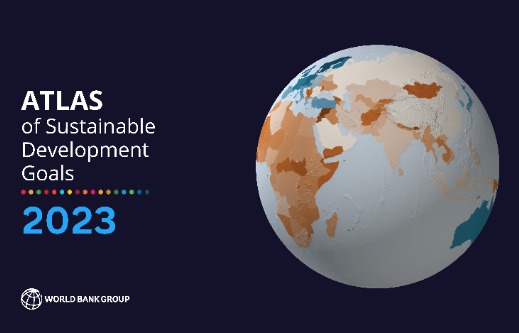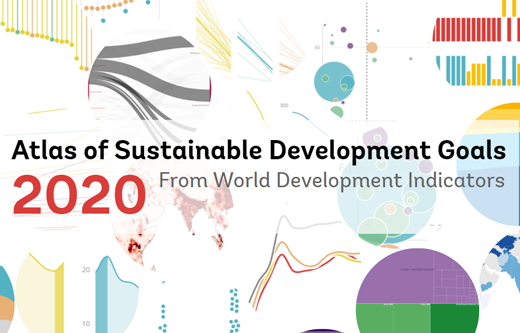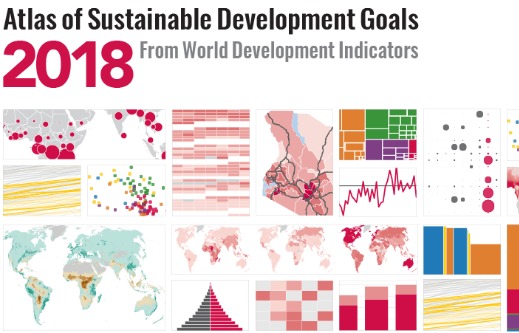
Development assistance as a catalyst for progress

Remittances: a lifeline for many economies

Partnership for global development
Overview
The world economy is bound together by financial flows, trade in goods and services, and movements of people. As national economies develop, the links between them expand and grow more complex.
The Global Links indicators provide an overview of the flows and associations that enable the world’s economy—and the economies of individual countries—to grow and expand. These indicators measure the size and direction of these flows, and document policy interventions such as tariffs, trade facilitation, and aid flows.
What types of data are available?
External indebtedness affects a country’s creditworthiness and investor perceptions. Data on external debt are gathered through the World Bank’s Debtor Reporting System (DRS). The World Bank’s interest in debt statistics is both analytical and operational. At the analytical level, the Bank is a leading international source of information and analysis on the economic situation of developing countries. At the operational level, the lending activities of the Bank demand a close monitoring of the overall financial situation of each borrower, such as a country’s debt-servicing capacity.
Data on other financial flows such as foreign direct investment (FDI) or aid are also available in the WDI. Distinguished from other kinds of international investment, FDI is made to establish a lasting interest in or effective management control over an enterprise in another country. The WDI provides data showing total net FDI, FDI net inflows and outflows, as well as information on portfolio equity investment. Aid flows aim to support sustainable development and to promote inclusive economic growth, including poverty reduction and improvement of living standards for the most disadvantaged. Indicators in the WDI provide information on aid dependency, as measured through the official aid flows data published by the Development Assistance Committee (DAC) of the Organization for Economic Co-operation and Development (OECD).
Trade in goods, or merchandise trade, includes all goods that add to or subtract from an economy’s material resources. Trade data are collected on the basis of a country’s customs area, which in most cases is the same as its geographic area. Trade data (including merchandise trade, tariffs, or net barter terms of trade) are drawn from a variety of sources such as the United Nations Statistics Division’s Commodity Trade Statistics (Comtrade) database, the World Trade Organization (WTO), and the International Monetary Fund (IMF). Collecting trade statistics can be difficult in countries which lack the capacity to report timely data and countries whose territorial boundaries are porous. In addition, economic and political concerns regarding strategic goods or the exports of a dominant producer, efforts to avoid taxes, or black-market trading, can create challenges in the reporting of certain trade flows.
The Global Links section also encompasses indicators used to measure the movement of people across borders. Time series data is available for net migration, personal remittances, and the number of refugees by country of origin and by country of asylum.
The relevance of the flows and partnerships presented in this section is recognized by several SDG goals, particularly SDG Goal 10 on reducing inequalities within and among countries, and Goal 17 on global partnerships for sustainable development. Specifically, the indicator on net official development assistance (ODA) received as a share of GNI is used to monitor the SDG target 17.2 on the implementation of official development assistance commitments. Countries’ total debt service as a proportion of exports of goods and services is the lead indicator used to monitor SDG target 17.4, which aims to assist developing countries in attaining long-term debt sustainability.
Featured Indicators
A selection of relevant indicators is presented below. The table shows, for each featured indicator, time coverage per year, for all countries, for each decade since the 1960s, and regional coverage for each World Bank geographical region since 2010. For detailed thematic lists please refer to the World Development Indicators Statistical Tables.
| External debt | ||||
|---|---|---|---|---|
| Indicator | Code | Time coverage | Region coverage | Get data |
|
External debt stocks, total (DOD, current US$)
|
DT.DOD.DECT.CD |






|







|
|
|
External debt stocks, short-term (DOD, current US$)
|
DT.DOD.DSTC.CD |






|







|
|
|
External debt stocks, long-term (DOD, current US$)
|
DT.DOD.DLXF.CD |






|







|
|
|
External debt stocks, public and publicly guaranteed (PPG) (DOD, current US$)
|
DT.DOD.DPPG.CD |






|







|
|
|
External debt stocks, private nonguaranteed (PNG) (DOD, current US$)
|
DT.DOD.DPNG.CD |






|







|
|
|
Total debt service (% of exports of goods, services and primary income)
|
DT.TDS.DECT.EX.ZS |






|







|
|
| Trade | ||||
| Indicator | Code | Time coverage | Region coverage | Get data |
|
Merchandise trade (% of GDP)
|
TG.VAL.TOTL.GD.ZS |






|







|
|
|
Net barter terms of trade index (2000 = 100)
|
TT.PRI.MRCH.XD.WD |






|







|
|
| Financial flows | ||||
| Indicator | Code | Time coverage | Region coverage | Get data |
|
Foreign direct investment, net inflows (BoP, current US$)
|
BX.KLT.DINV.CD.WD |






|







|
|
|
Personal remittances, received (current US$)
|
BX.TRF.PWKR.CD.DT |






|







|
|
|
Portfolio equity, net inflows (BoP, current US$)
|
BX.PEF.TOTL.CD.WD |






|







|
|
| Aid dependency | ||||
| Indicator | Code | Time coverage | Region coverage | Get data |
|
Net official development assistance and official aid received (current US$)
|
DT.ODA.ALLD.CD |






|







|
|
|
Net official development assistance received (current US$)
|
DT.ODA.ODAT.CD |






|







|
|
|
Net ODA received (% of GNI)
|
DT.ODA.ODAT.GN.ZS |






|







|
|
| Refugees | ||||
| Indicator | Code | Time coverage | Region coverage | Get data |
|
Refugee population by country or territory of asylum
|
SM.POP.REFG |






|







|
|
|
Refugee population by country or territory of origin
|
SM.POP.REFG.OR |






|







|
|
| Tourism | ||||
| Indicator | Code | Time coverage | Region coverage | Get data |
|
International tourism, receipts (% of total exports)
|
ST.INT.RCPT.XP.ZS |






|







|
|
|
International tourism, expenditures (% of total imports)
|
ST.INT.XPND.MP.ZS |






|







|
|
| Migration | ||||
| Indicator | Code | Time coverage | Region coverage | Get data |
|
Net migration
|
SM.POP.NETM |






|







|
|
About the data
External debt
External indebtedness affects a country’s creditworthiness and investor perceptions. Data on external debt are mainly from reports to the World Bank through its Debtor Reporting System (DRS) from member countries that have received International Bank for Reconstruction and Development loans or International Development Assistance credits, with additional information from the files of the World Bank, the IMF, the African Development Bank and African Development Fund, the Asian Development Bank and Asian Development Fund, and the Inter-American Development Bank. Summary tables of the external debt of low- and middle-income countries are published annually in the World Bank’s International Debt Statistics and International Debt Statistics database. The debt portal is a central hub that provides information on debt statistics through three databases: International Debt Statistics with a detailed picture of debt stocks and flows of low- and middle-income countries and Quarterly External Debt and Quarterly Public Sector Debt databases with the debt stock of high income countries collected by the World Bank.
Indebtedness is calculated using loan-by-loan reports submitted by countries on long-term public and publicly guaranteed borrowing and information on short-term debt collected by the countries, from creditors by the Bank for International Settlements, or based on national data from the World Bank’s Quarterly External Debt Statistics. These data are supplemented by information from major multilateral banks and official lending agencies in major creditor countries. Currently, 123 low- and middle-income countries report to the DRS. Debt data are reported in the currency of repayment and compiled and published in U.S. dollars. End-of-period exchange rates are used for the compilation of stock figures (amount of debt outstanding), and projected debt service and annual average exchange rates are used for the flows. Exchange rates are taken from the IMF’s International Financial Statistics. Debt repayable in multiple currencies, goods, or services and debt with a provision for maintenance of the value of the currency of repayment are shown at book value.
While data related to public and publicly guaranteed debt are reported to the DRS at the loan level, data on long-term private nonguaranteed debt are reported annually in aggregate form by the country or estimated by World Bank staff based on national data from the Quarterly External Debt Statistics.
Total debt service as a share of exports of goods, services, and primary income provides a measure of a country’s ability to service its debt out of export earnings.
Note: Starting with World Development Indicators 2013, the World Bank adapted its presentation of balance of payments data to conform to the IMF Balance of Payments Manual, 6th edition (BPM6). For more information, see Balance of payments manual at Economy.
Trade in goods
Data on merchandise trade are from customs reports of goods moving into or out of an economy or from reports of financial transactions related to merchandise trade recorded in the balance of payments. Because of differences in timing and definitions, the trade flow estimates from the two sources may differ. Several international agencies process trade data, each correcting unreported or misreported data, which leads to other differences. The most detailed source of data on international trade in goods is the United Nations Statistics Division’s Commodity Trade Statistics (Comtrade) database. The IMF and the World Trade Organization also collect customs-based data on trade in goods.
The terms of trade index measures the relative prices of a country’s exports and imports. The most common way to calculate terms of trade is the net barter (or commodity) terms of trade index, or the ratio of the export price index to the import price index. A country’s net barter terms of trade index goes up when its exports have become more expensive or its imports cheaper. Data on trade indexes are from the annual Handbook of Statistics published by the United Nations Conference on Trade and Development’s (UNCTAD).
Equity flows
Equity flows comprise foreign direct investment (FDI) and portfolio equity. The internationally accepted definition of FDI (from BPM6) includes the following components: equity investment, including investment associated with equity that gives rise to control or influence; investment in indirectly influenced or controlled enterprises; investment in fellow enterprises; debt (except selected debt); and reverse investment. The Framework for Direct Investment Relationships sets out criteria for determining whether cross-border ownership results in a direct investment relationship based on control and influence. Data on FDI are World Bank staff estimates based on IMF balance of payments statistics and UNCTAD data. Data on portfolio equity are from the IMF Balance of Payments Statistics Yearbook.
Direct investments may take the form of greenfield investment, where the investor starts a new venture in a foreign country by constructing new operational facilities; joint venture, where the investor enters into a partnership agreement with a company abroad to establish a new enterprise; or merger and acquisition, where the investor acquires an existing enterprise abroad. The IMF suggests that investments should account for at least 10 percent of voting stock to be counted as FDI; in practice many countries set a higher threshold. Many countries fail to report reinvested earnings, and the definition of long-term loans differs among countries.
Portfolio equity investment is defined as cross-border transactions and positions involving equity securities other than those included in direct investment or reserve assets. Equity securities are equity instruments that are negotiable and designed to be traded, usually on organized exchanges or “over the counter.” The negotiability of securities facilitates trading, allowing securities to be held by different parties during their lives. Negotiability allows investors to diversify portfolios and to withdraw an investment readily. Included in portfolio investment are investment fund shares or units that are evidenced by securities and that are not reserve assets or direct investment. Although they are negotiable instruments, exchange-traded financial derivatives are not considered portfolio investment but treated as a separate category.
Aid dependency
Data on official development assistance (ODA) received refer to aid to eligible countries from members of the Development Assistance Committee (DAC) of the Organisation of Economic Co-operation and Development (OECD), multilateral organizations, and non-DAC donors. Data do not reflect aid given by recipient countries to other low- and middle-income countries; nor do they distinguish between types of aid (program, project, or food aid; emergency assistance; or post-conflict peacekeeping assistance) the effects of which on the economy may differ. Data on net ODA are compiled by the OECD.
Ratios of aid to gross national income (GNI), gross capital formation, imports, and government spending measure a country’s dependency on aid. Policy conclusions should be drawn carefully. For foreign policy reasons some countries have traditionally received large amounts of aid. Thus, aid dependency ratios may reveal as much about a donor’s interests as about a recipient’s needs. Increases in aid dependency ratios can reflect events affecting both the numerator (aid) and the denominator (GNI).
Data are based on information from donors and may not be consistent with information recorded by recipients in the balance of payments, which often excludes all or some technical assistance—particularly payments to expatriates made directly by the donor. Similarly, commodity aid grants may not always be recorded in trade data or in the balance of payments. DAC statistics exclude aid for military and antiterrorism purposes. The aggregates refer to World Bank classifications of economies, which may differ from OECD classifications.
Refugees
Refugees are people who are recognized as refugees under the 1951 Convention Relating to the Status of Refugees or its 1967 Protocol, the 1969 Organization of African Unity Convention Governing the Specific Aspects of Refugee Problems in Africa, and people recognized as refugees in accordance with the UNHCR statute, people granted refugee-like humanitarian status, and people provided temporary protection. Asylum seekers--people who have applied for asylum or refugee status and who have not yet received a decision or who are registered as asylum seekers--are excluded. Palestinian refugees are people (and their descendants) whose residence was Palestine between June 1946 and May 1948 and who lost their homes and means of livelihood as a result of the 1948 Arab-Israeli conflict. Country of asylum is the country where an asylum claim was filed and granted. The aggregates refer to World Bank classifications of economies and therefore may differ from those reported by the OECD.
Tourism
Tourism is defined as the activity of people traveling to and staying in places outside their usual environment for no more than one year for leisure, business, and other purposes not related to an activity remunerated from within the place visited. Data on inbound and outbound tourists refer to the number of arrivals and departures, not to the number of unique individuals—a person who makes several trips to a country during a given period is counted each time as a new arrival. Data on inbound tourism show the arrivals of nonresident tourists (overnight visitors) at national borders. When data on international tourists are unavailable or incomplete, the World Development Indicator database shows the arrivals of international visitors, which include tourists, same-day visitors, cruise passengers, and crew members. The aggregates are calculated using the World Bank’s weighted aggregation methodology (see Sources and methods) and differ from the World Tourism Organization’s aggregates.
For tourism expenditure, the World Tourism Organization uses IMF balance of payments data supplemented by data from individual countries. These data cover travel and passenger transport items as defined by the BPM6. When the IMF does not report data on passenger transport items, expenditure data for travel items are shown.
Migration and personal remittances
The movement of people, most often through migration, is a significant part of global integration. Migrants contribute to the economies of both their host country and their country of origin. Yet reliable statistics on migration are difficult to collect and are often incomplete, making international comparisons difficult.
Since data on emigrant stock is difficult for countries to collect, the UN Population Division provides data on net migration, taking into account the past migration history of a country or area, the country’s migration policy, and the influx of refugees in recent periods to derive estimates of net migration. Data for calculating the estimates come from such sources as border statistics, administrative records, surveys, and censuses. When the data are not sufficient, net migration is derived as the difference between the growth rate of a country’s population over a certain period and the rate of natural increase of that population, which is the difference between the birth rate and the death rate.
Migrants often send funds back to their home countries, which are recorded as personal transfers in the balance of payments. Personal transfers thus include all current transfers between resident and nonresident individuals, independent of the source of income of the sender (irrespective of whether the sender receives income from labor, entrepreneurial or property income, social benefits, or any other types of transfers or disposes of assets) and the relationship between the households (irrespective of whether they are related or unrelated individuals).
Compensation of employees covers the income of border, seasonal, and other short-term workers employed in an economy where they are not resident and that of residents employed by nonresident entities. Compensation of employees has three main components: wages and salaries in cash, wages and salaries in kind, and employer social contributions. Personal remittances are the sum of personal transfers and compensation of employees. Data on personal remittances are from the IMF Balance of Payments Statistics Yearbook supplemented by World Bank staff estimates.